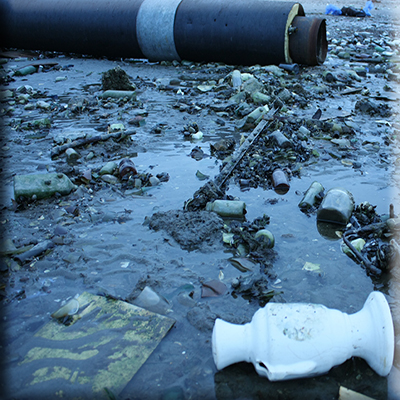Ecologies is a new thread for Lateral and an experiment in practice-based, multi-modal and multi-venue presentation of work in cultural studies. As the Design Editor for Lateral since its inception, I have worked with many contributors and thread editors to produce conversations in web-based publishing that emerge from the membership and annual conference of the Cultural Studies Association, and while these works (all of which can be found right here on Lateral) trace back to our annual gathering, these publications essentially function outside of the conference itself.
Ecologies: Trash, Toxicity, Transmission
Circuits to the Past
This series of photographs tracks digital signals across nine nodes of our fiber-optic undersea cable network – a system responsible for carrying 99% of all transoceanic internet traffic. The images document cable landings in the United States, Australia, New Zealand, and Tahiti, sites where submarine systems come aground and become entangled in the existing movements of both humans and nonhumans. Rather than locating us in an urban landscape, “Signal Tracks” hones in on the cable system’s rural and aquatic environments, extending from breaking waves over Sydney’s beaches, to mountains where brush fires scour O‘ahu’s west shore, to the habitats of endangered mountain beavers in northern California. Although on the surface these images appear absent of industrial infrastructure, the accompanying textual annotations highlight how such “natural” ecologies have been folded into contemporary digital systems.
E-Waste
My artwork investigates the materiality of digital culture, and the ways that our contemporary lavish lives are so dependent on the overlooked labor of lowbrow machines. E-Waste is a new sculptural investigation that incorporates a broad spectrum of USB-powered devices. The objects are partially encrusted with both “natural” and “man-made” environmental materials, yet these half-fossilized mutants continue to function, providing sources of light, sound, and movement.
Money as Medium, Speculation and Scrypt
Although they intervened on a culture of financialization in two very different ways, both Speculation and scrypt explore the intersection of money with the history of media, imperialism, colonialism, and computation. If capitalism is a kind of computer, a difference engine propagating vectors of exchange, these projects attempted to reprogram its operations. Apart from exploring the homology between money, language, computation, and philosophies of abstraction, Speculation and scrypt engage in collaborative practices that interrupt forms of classroom pedagogy based around the concept of the neoliberal individual (and neoliberal university). When money is pursued not for profit, but play, and when money is transformed from a medium of exchange to a medium for artistic practice, these two moneygames make invisible hands visible.
L.U.N.G.S
LUNGS is an activist research project investigating pollution as a cause of diseases of poverty, first by interrogating how pollution information is collected and analyzed, and then by creating low-cost, remote-deployable pollution sensor kits to enable more informed decision-making in relationship to local, real-time pollution and health.
Topographies of Interference
‘Topographies of Interference’ is meant to provoke viewers into thinking about information services’ material presence in the world, and to relocate the vision of large tech companies as primarily urban centers to one that highlights their presence in more rural communities, which often receives less attention.
Long Time No Ocean
Words on flagging banners are cut out, with letters left hanging; phrases like “Long Time No Ocean” become difficult to read. Language here functions in dual ways as both a communicative tool and an evocative form. In the absence, concealment, or constant rebuilding, a space opens up for a shift of meaning and it is this moment of shift that I am particularly interested in.
Make(r) Space, Making Space: A Media Ecology in Two Parts
The pop-up maker space hosted by the Media Interventions working group of the Cultural Studies Association at the 2014 annual meeting, ‘Ecologies: Relations of Culture, Matter, and Power,’ is a collaborative intervention into the typical structure of academic conferences in the interdisciplinary humanities and social sciences, whose genres and formats tend to privilege established scholars, disciplinary paradigms, the new, and above all a mindset in which the resources attached to ‘professionalization’ are governed by scarcity. Held concurrently with the main conference schedule at the University of Utah’s historic Pierre Lassonde House, the maker space showcases the work of artists, activists, media practitioners, performers, researchers, and amateur ‘makers,’ inviting conference attendees to engage the material not merely as spectators but as active participants in the collective meanings of the event. In doing so, it quite literally makes space for multimodal methods of knowledge production that decenter the individual and scramble the dominant temporalities of academic labor. This two-part essay describes the maker space as media ecology in the process of unfolding across multiple time frames (and time zones) and through unevenly distributed agencies as well as affective states. The first part documents the process of making a space for making, while the second attempts to partially capture and re-present the event itself through digital photography, video clips, sound snippets, links, maps, and other media ancillary to the maker space. In reading, watching, listening, touching, clicking, and otherwise attending to what we are making, you become integrated into the circuitry of our affections: the queer collection of things that comprise media ecologies.
#bottlesNbones
#bottlesNbones is one part of a multi-site project, #trashNtoxicity examining the irremediable, abandoned, unrecycleable, and non-biodegradeable postnatural affects of human production.
